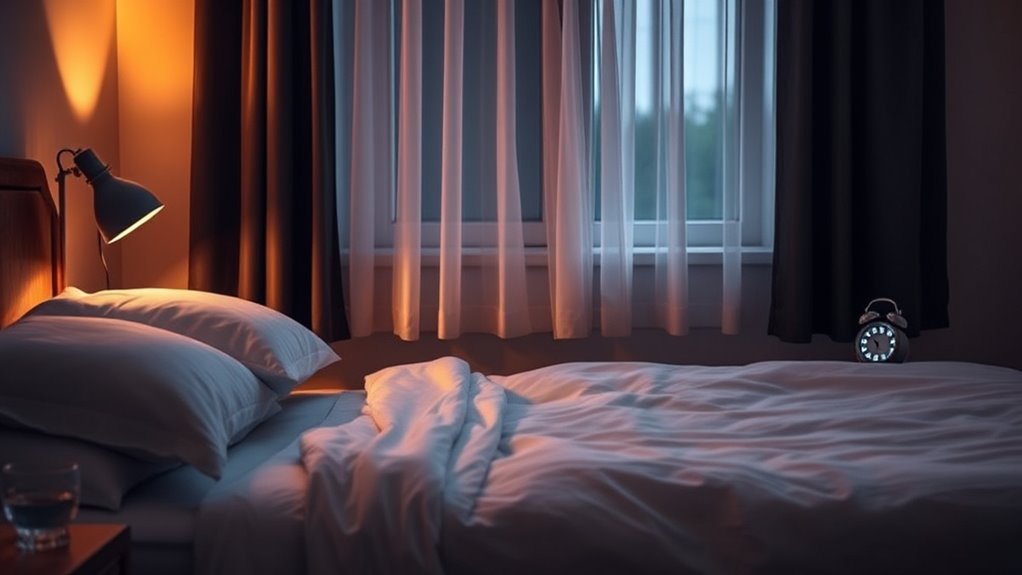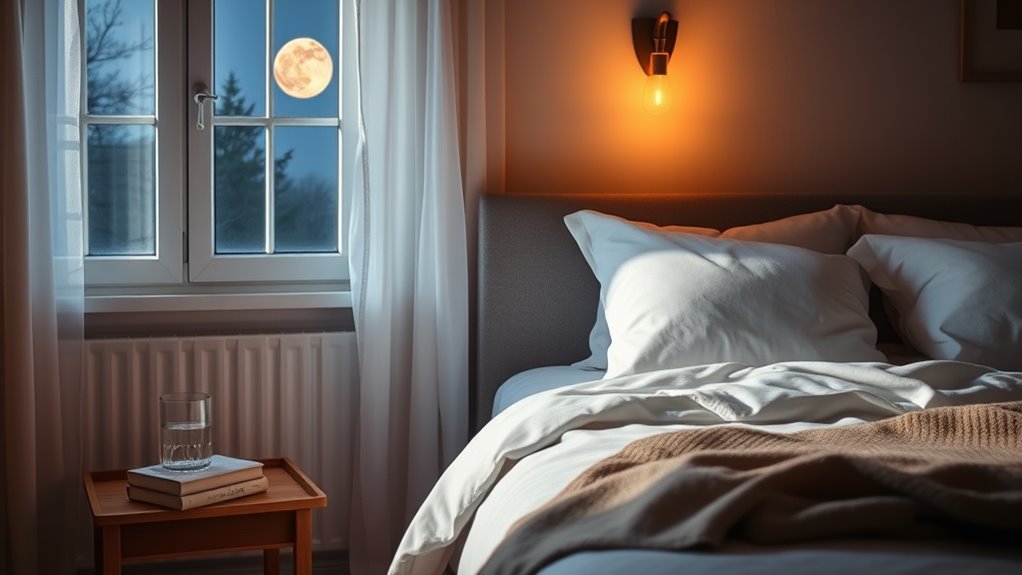To do a quick 10-minute sleep tune-up, start by turning off screens and dimming the lights to boost melatonin. Engage in calming activities like gentle stretches, deep breathing, or listening to soothing music. Make your room cooler, quiet, and dark to create a sleep-friendly environment. Use relaxing rituals like herbal tea or mindfulness to signal your body it’s time to wind down. Keep going, and you’ll discover more simple ways to enhance your sleep tonight.
Key Takeaways
- Establish a consistent bedtime and wake-up schedule, including calming pre-sleep activities like reading or listening to soothing music.
- Optimize your bedroom environment by maintaining a cool temperature, using blackout curtains, and minimizing noise disruptions.
- Remove electronic devices from the sleeping area and avoid screens at least 30 minutes before bed to reduce blue light exposure.
- Incorporate light stretching, deep breathing, or mindfulness practices in your routine to promote relaxation and ease sleep onset.
- Make small, intentional adjustments over time to reinforce healthy sleep habits and create a more inviting sleep space.
Simple Steps for Better Sleep Tonight

Getting quality sleep doesn’t have to take hours of effort. In just ten minutes, you can create a sleep-friendly environment and establish bedtime routines that set you up for restful nights. The key lies in simple, intentional adjustments that signal to your body it’s time to wind down. Start by focusing on your bedtime routines. Consistency is vital, so aim to go to bed and wake up at the same times each day, even on weekends. Before you sleep, engage in calming activities like reading, gentle stretching, or listening to soothing music. Avoid screens at least 30 minutes before bed, as the blue light emitted by phones and computers interferes with melatonin production. Instead, consider a relaxing herbal tea or meditation to help your mind shift into sleep mode. These short, mindful rituals cue your body that it’s time to rest, making it easier to fall asleep quickly and stay asleep longer.
Next, pay close attention to your bedroom environment. Your sleep space should be a sanctuary free of distractions. Keep the room cool, ideally between 60-67°F, since a lower temperature promotes deeper sleep. Darkness is equally important—use blackout curtains or an eye mask to block out light, which can disrupt your circadian rhythm. Noise can also be a barrier to restful sleep, so if you’re sensitive, try earplugs or a white noise machine to drown out disturbances. Your bed itself matters too; ensure your mattress and pillows provide proper support and comfort. Keep the bedroom tidy and clutter-free to create a calming atmosphere that encourages relaxation. Removing electronic devices from your sleeping area can greatly improve sleep quality because they emit light and can tempt you to stay awake longer. Additionally, incorporating sleep-promoting accessories like blackout curtains or white noise machines can significantly enhance your sleep environment.
In these ten minutes, you can also prepare your mind for sleep by doing some light stretching or deep breathing exercises. These activities help reduce stress and lower your heart rate, making it easier to drift off. Remember, small adjustments to your bedtime routines and bedroom environment can have a big impact on your sleep quality. Creating a consistent, inviting space combined with calming pre-sleep practices trains your body to recognize when it’s time to wind down. Over time, these habits become second nature, leading to faster sleep onset and more restorative nights. So, in just ten minutes, you can set the stage for better sleep tonight and improve your overall sleep hygiene for the future.
Frequently Asked Questions
Can Sleep Hygiene Improvements Reduce Chronic Insomnia?
Yes, improving your sleep hygiene can reduce chronic insomnia. By creating a better sleep environment—like keeping your room dark, cool, and quiet—you’ll foster relaxation. Establishing consistent bedtime routines helps signal your body it’s time to sleep, making it easier to fall asleep and stay asleep. These small changes build healthy habits that can considerably lessen insomnia symptoms, leading to more restful, restorative sleep night after night.
Are There Specific Foods That Support Better Sleep Hygiene?
You can boost your sleep hygiene by choosing sleep-friendly snacks that contain sleep-boosting nutrients. Foods like bananas, almonds, and dairy provide magnesium and tryptophan, which promote relaxation and melatonin production. Incorporate these into your evening routine, and you’ll support better sleep naturally. Avoid heavy or spicy foods close to bedtime, as they can disrupt sleep. Focus on light, nutrient-rich snacks to help you wind down effectively.
How Long Does It Take to See Sleep Improvements?
In just a few nights, you’ll start noticing subtle shifts in your sleep pattern and increased sleep duration. Your body appreciates the consistency and small adjustments you make, gradually leading to more restful nights. While some changes are quick, it may take a week or two to truly feel the benefits. Stay patient and persistent; your improved sleep routine will reward you with better rest and renewed energy.
Is Exercise Recommended Close to Bedtime for Better Sleep?
Evening workouts are generally not recommended close to bedtime because they can boost your energy levels and make falling asleep harder. Instead, opt for gentle activities like bedtime stretching, which help relax your muscles and calm your mind. If you want better sleep, schedule your exercise earlier in the day, and save relaxing routines for right before bed to promote deep, restful sleep.
Can Sleep Hygiene Tips Help With Sleep Apnea Symptoms?
Imagine you improve your sleep environment with a cool, dark room and practice relaxation techniques like deep breathing. These steps can help reduce sleep apnea symptoms by promoting better overall sleep quality. While they won’t replace medical treatment, good sleep hygiene can lessen your discomfort, making breathing easier at night. Consistently practicing these habits supports your health and may improve your sleep apnea symptoms over time.
Conclusion
Now that you know these simple steps, sleep becomes smoother and sweeter. By brushing off bedtime barriers, creating a calm, consistent routine, and avoiding screens, you’re setting yourself up for success. Sleep better tonight and tomorrow by sticking to these small, steady steps. Remember, a peaceful, perfect night’s rest begins with your proactive preparation. So, take charge, stay consistent, and enjoy the sweet serenity of a truly restful sleep. Sleep soundly and start each morning fresh!










